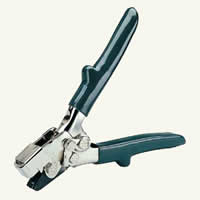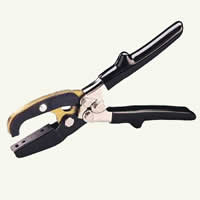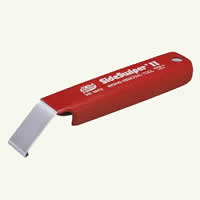Note: The following instructions and information should be considered to be a general guideline. Always follow the manufacturer's detailed installation instructions.
Tools:
The tools required to install vinyl siding are, with the exception of three hand tools, the tools that should be in a home handyman's tool bag.
- Chalk Line
- Level (48" recommended)
- Circular Saw with fine tooth blade
- Laser Level
- Utility Knife
- Ladder
- Tape measure (min 16')
- Work Bench or Saw Horses
- Tin Snips or Aviation Snips
- Carpenter's Square
- Hacksaw (fine tooth blade)
- Caulking Gun
The three special tools are:

Snap lock Punch

Nail Hole Punch

Siding Removal Tool
The snap lock punch is used to secure the vinyl siding and skirting to finished trim. Tabs grip a greater surface area and guard against dislodging due to relaxation of vinyl from heat and wind.
The nail hole punch creates an oval hole in the vinyl siding for nail placement. It is critical in order to allow expansion and contraction of the vinyl siding
The siding removal tool allows the installer to remove pieces of siding without damaging them and keeps the installers knuckles well away from the work.
Calculating the siding, trim, soffit and fascia material requirements:
Preparing The Surface To Accept The Installation Of Vinyl Siding:
As with most home improvement projects, the end result is determined by the preparation work. Installing siding is no different. The preparation of the surface is critical to a successfully completed project.
Note: If you are planning on painting any of the exterior of your home, paint before you install the new siding.
Residing:
- Angled Siding: If you currently have a siding on your home which is wide at the bottom of the panel and narrow at the top it is my recommendation that the siding be removed. Although many selfhelp books and tutorials show siding being placed on top of angled siding, in my experience you will have no end of installation problems. The effort involved in removing the siding, is far less than the effort involved in trying to cover it.
- Flat Siding:
- Masonry Walls:
- Bare Exterior Wall:
- If you have a new home or have removed the current siding or veneer and have just the backerboard or sheathing remaining, you have the easiest starting point for your new siding.
- Do not apply siding directly over the wall studs. There must be a sheathing or backerboard installed over the studs.
- You can install the siding directly over foam backerboard. In this instance you must ensure that when nailing the nails penetrate a wall stud.
If the current siding on your home is basically flat, you can apply siding directly over it.
Using nails and screws, as appropriate, ensure that the current siding is tightly fastened to the walls.
If there are any areas of the current siding which are rotten, replace them with a suitable material. Leaving rotting material underneath new siding will not prevent the old siding from continuing to rot which may eventually lead to mold growing under the new siding.
Repair or replace any window sills or window and door trims, that are damaged.
Remove any loose caulking from around window and door frames. Apply new caulking to these areas.
Remove any light fixtures, hose reels, receptacle face plates, downspouts and associated fittings and remove the gutter if you are going to install a new fascia.
If you are applying siding over any masonry surface such as concrete blocks, brick, or stucco you will have to apply furring strips in order to have a nailing or stapling surface.
The furring strips should be installed on 16 inch centers, opposite to the direction of the installed siding.
Direction Of Siding
Horizontal
Vertical
Direction Of Furring Strip
Vertical
Horizontal
Fill the spaces between and flush with the furring strips with a backerboard or foam insulation so that the finished grouping of furring strips and filler is flat. House wrap may be applied over the furring strips and filler material. Before applying the house wrap, mark the location of the furring strips so that you can hit one when nailing the siding.
